This is the fourth in the series of posts under the topic “Understanding the KGFS Customer”. The authors, Sowmya Vedula and Shilpa Sathe of IFMR Rural Finance, present data regarding occupations of KGFS customer. The information is as declared by the customer at the time of enrolment or at the time of any periodic updating of data.
Notes:
- This blog post displays data of all enrolled members of the three KGFSs, Pudhuaaru (Tamil Nadu), Dhanei (Orissa) and Sahastradhara (Uttarakhand), obtained from the datasets of the Customer Management System (CMS)
- Data considered for this post is as of November 15, 2011
- Pudhuaaru has 1,29,380 enrolled customers, Dhanei has 25,654 and Sahastradhara has 20,253 which brings the number to a total of 1,75,287
- This post also uses data of family members of enrolled customers from our customer management database. The total number of individuals considered for the analysis is thus 3,35,627 for Pudhuaaru, 88,452 for Dhanei and 85,316 for Sahastradhara
- Customers can enrol at any time throughout the year and hence the data collected is at different points in time
- Categories of occupations in the database are –Agriculture and allied activities, labour, migrant labour, student, business, working abroad, salaried, unemployed, housewife, and retired/pensioner. Agriculture and allied activities include people who own land and cultivate it, people engaged in fishing and dairy, and traders of crops and agricultural products. ‘Others’ includes income from self-employment in activities other than those listed above.
Overall Occupation Distribution
Chart 1 below shows the overall distribution of occupations by categories. Students are the largest in number (26.58%) followed by labourers (22.4%) and people pursuing agriculture and allied activities (13.6%). The number of unemployed people is also significant and amounts to 13.27%.
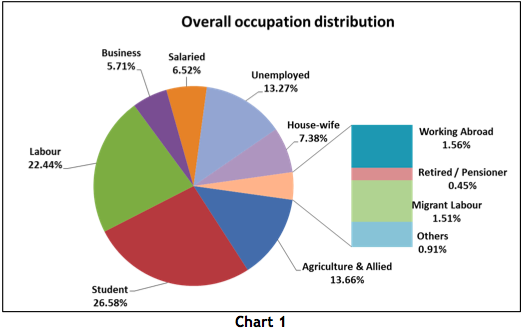
Chart 2 shows the distribution of occupations by KGFS entity. In Pudhuaaru and Dhanei, students and labourers form majority of the population. The unemployment rate is higher in these two geographies (14%-16%). The proportion of labourers migrating within India is the highest in Dhanei as compared to the other two geographies while the number of international migrants is higher in Pudhuaaru. In Sahastradhara, about one third of the population is students followed by agriculture and allied activities (25.4%) and salaried people (13%).

Most Common Combinations of Occupations
There are 15,648 individuals (5.77% of the total earning population) who are involved in more than one occupation overall. Chart 3 shows the most common combinations of occupations followed by these individuals. For example, there are 6771 labourers who also cultivate their own land, 2037 businessmen who are involved in dairy and 1175 labourers who are also involved in dairy activities.
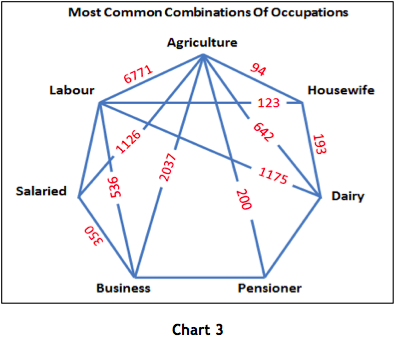
Gender Wise Distribution of Occupations
Chart 4, 5 and 6 show the distribution of occupations by gender across the three KGFS entities. Noticeably, it’s a good sign to see almost equal number of male and female students across the three geographies. Wage labour is the most common activity taken-up by women in Pudhuaaru (25.89%) and Dhanei (19.37%) whereas in Sahastradhara majority of women are involved in agriculture and allied activities (43.70%). Migration among women is not a common trend and only 0.24% of women in all three geographies migrate for work within the country and abroad. The percentages of women who are unemployed are as follows: Pudhuaaru – 18.78%, Dhanei – 21.16% and Sahastradhara – 17.35%.
Among men, the distribution of occupations varies widely among categories in the three geographies. In Pudhuaaru, majority of men are either labourers (30.30%) or are involved in agriculture and allied activities (14.88%) whereas in Dhanei they are more or less equally distributed among agriculture & allied activities (13.94%), business (15.20%), labour work (15.40%) and domestic migration (13.80%). In Sahastradhara however, majority of the men are salaried (22.03%), followed by business (14.91%) and agriculture & allied activities (10.93%).
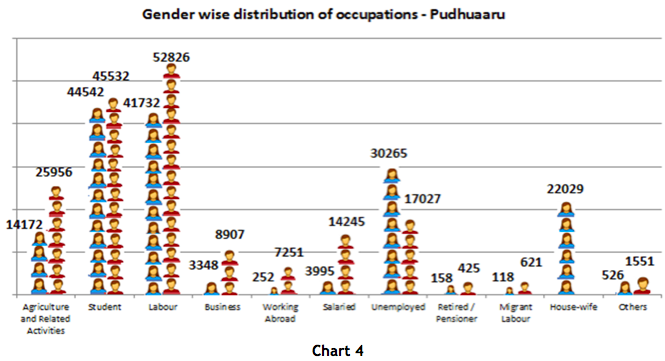
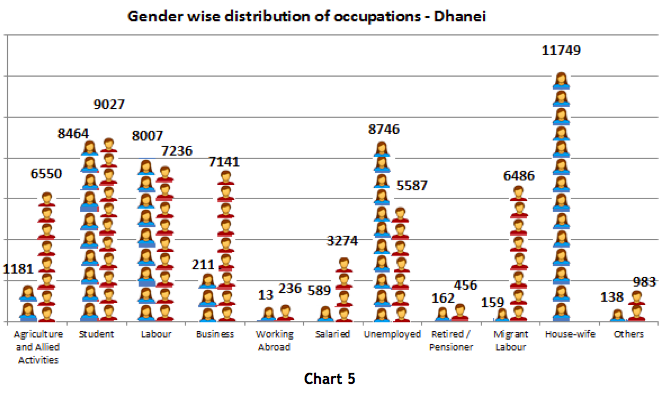
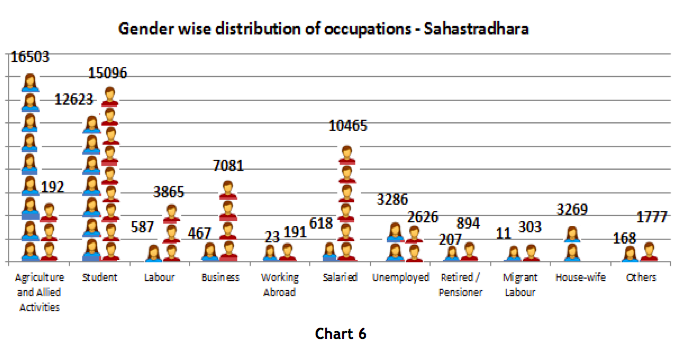
Distribution of Occupations by Age-Group
Charts 7, 8 and 9 represent the distribution of occupations by age-group. In all three geographies majority of individuals between the age of 1 and 20 are students. In the age group of 20 to 60, which is the productive age, majority of individuals are labourers (25.44%) in Pudhuaaru, while in Dhanei the majority is labourers (14.32%) and businessmen (9.48%). In Sahastradhara, most people are involved in agriculture (22.73%) and salaried employment (12.71%). Overall, domestic and international migration is observed mainly within the age group of 20 and 40 (73.33% of international migrants and 65.65% of domestic migrants). In the age group beyond 60, there is a significant difference in occupations among Pudhuaaru, Dhanei and Sahastradhara. In Pudhuaaru and Dhanei most individuals in this category (39.68% and 49.50% respectively) are unemployed while in Sahastradhara, this number is less than 19%.
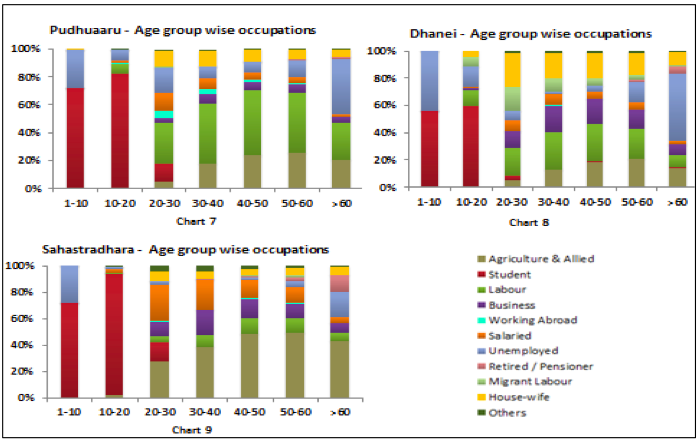
Distribution of Occupations by Level of Education
Next, we look at the distribution of occupations by the highest level of education completed. Table 1 shows the overall distribution, while charts 10, 11 and 12 show the KGFS-wise distribution. Overall, 37.5% of the population has an education between 6th and 12th standard. Only 6% of the population has pursued graduate, post-graduate or vocational courses and the majority of these individuals are salaried employees, businessmen or are working abroad. Around 50% of the unemployed individuals cannot read and write.
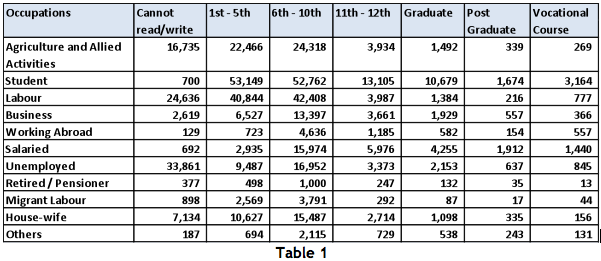
In all three geographies, majority of the people who have pursued graduation, post-graduation and vocational courses have a salaried job. However, in Pudhuaaru alone, about 20% of people in these categories are unemployed. Among people who have studied till the 10th standard, majority of them are labourers In Pudhuaaru, and labourers or business people in Dhanei. In Sahastradhara, majority of them are involved in agriculture & allied activities. Pudhuaaru has a large chunk (44%) of unemployed people who cannot read and write, followed by Dhanei (36%) and Sahastradhara (30%).
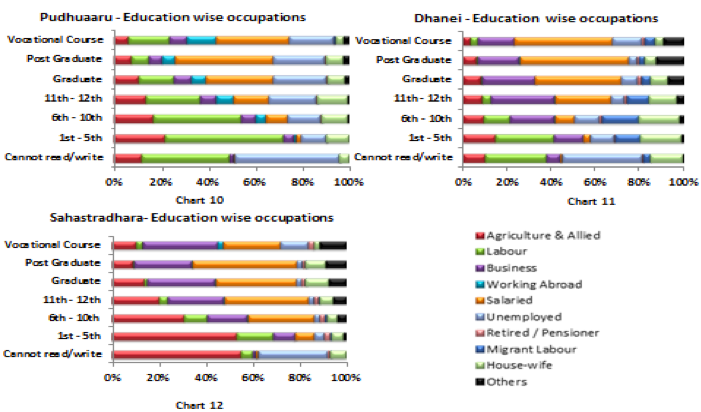
Our next blog post will talk in detail about the distribution of incomes for all the above parameters.

